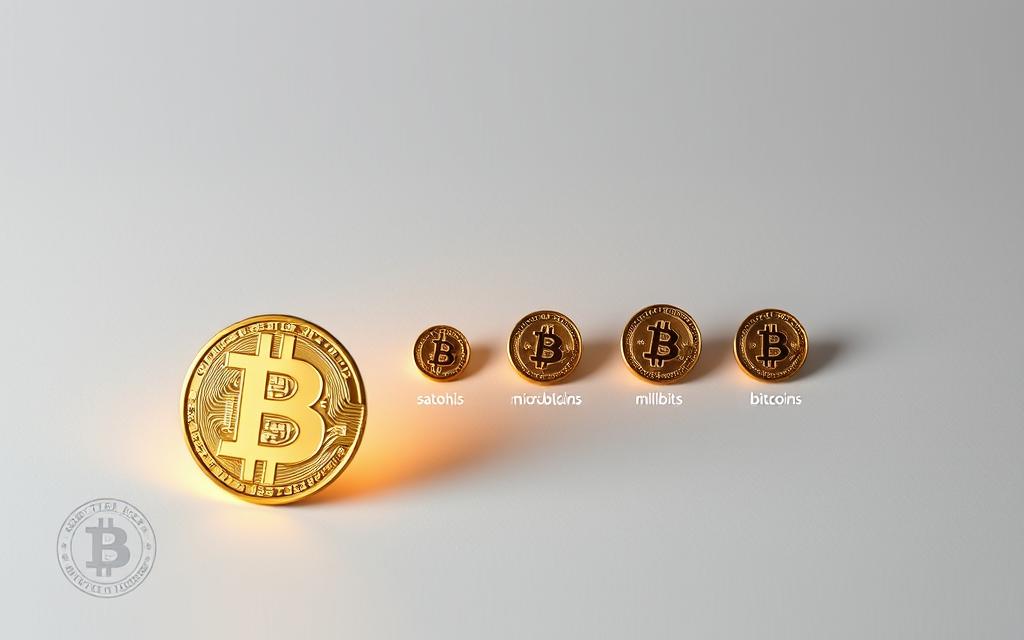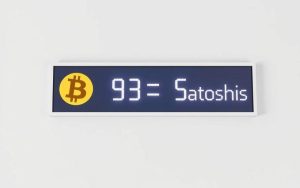Table of Contents
The world of cryptocurrency often involves dealing with large and small numbers, but understanding the fundamental unit of Bitcoin is crucial. A satoshi represents the smallest fraction of a Bitcoin, making it a vital component for microtransactions and everyday usage.
There are 100,000,000 satoshis in a Bitcoin. Each satoshi is equivalent to 0.00000001 BTC, providing a precise measurement for transactions of varying value. The term “satoshi” honors Bitcoin’s founder, Satoshi Nakamoto.
Understanding the relationship between satoshis and Bitcoin is essential for navigating the cryptocurrency ecosystem. This guide will explore the conversion basics, the role of satoshis in facilitating microtransactions, and their significance in the broader context of Bitcoin’s unit of measurement.
Understanding Bitcoin’s Smallest Unit
To grasp the flexibility of bitcoin, it’s essential to understand its smallest denomination.
The term “satoshi” is used to represent the smallest unit of bitcoin, facilitating microtransactions and enhancing the cryptocurrency’s usability.
What Is a Satoshi?
A satoshi is the smallest unit of bitcoin, equivalent to 0.00000001 BTC. It allows for transactions that are fractions of a bitcoin, making bitcoin more versatile.
The Origin of the Name
The term “satoshi” is named in honor of Satoshi Nakamoto, bitcoin’s founder. The naming process was community-driven, with “satoshi” eventually becoming the standard term by 2011.
How Many Sats in a Bitcoin: The Exact Conversion
Understanding the conversion rate between Bitcoin and satoshis is crucial for navigating the cryptocurrency landscape. The existence of satoshis gives Bitcoin great divisibility, allowing for transactions of extremely small amounts.
The Mathematical Breakdown
One Bitcoin is equal to 100 million satoshis. This means that even when Bitcoin’s value is high, it can still be divided into smaller, more manageable units. The precise conversion is as follows: 1 BTC = 100,000,000 sats.
Why Bitcoin Needs to Be Divisible
Bitcoin’s divisibility is not just a convenience; it’s a critical feature that enhances its scalability and accessibility. As Bitcoin’s value increases, this divisibility becomes increasingly important, allowing for practical everyday transactions despite the high value of whole coins. The benefits of this divisibility include enabling microtransactions and ensuring that Bitcoin remains accessible to users from all economic backgrounds.

Converting Between Bitcoin and Satoshis
The ability to convert between Bitcoin and its smallest unit, Satoshi, is essential for navigating the cryptocurrency landscape. This conversion is straightforward, relying on a simple mathematical formula.
Bitcoin to Satoshi Formula
To convert Bitcoin to Satoshis, you use the formula: Number of Satoshis = Amount of Bitcoin × 100,000,000. For instance, 0.01 Bitcoin is equivalent to 1,000,000 Satoshis. This conversion is crucial for understanding transaction amounts in different units.
Satoshi to Bitcoin Formula
Conversely, to convert Satoshis to Bitcoin, the formula is: Amount of Bitcoin = Number of Satoshis ÷ 100,000,000. For example, 1,000,000 Satoshis equals 0.01 Bitcoin. This calculation is particularly useful when receiving payments in Satoshis and needing to understand their Bitcoin value.
As stated by a cryptocurrency expert, “Understanding both conversion directions gives users complete flexibility in how they conceptualize and communicate Bitcoin values.” This flexibility is key to managing amounts in BTC effectively.
The Value of Satoshis in USD
As Bitcoin’s price fluctuates, so does the value of satoshis. This relationship makes it easier for new investors to enter the market by buying fractions of a Bitcoin.
Current Conversion Rates
The current value of satoshis in USD is directly proportional to Bitcoin’s price. For instance, if Bitcoin is priced at $50,000, one satoshi equals $0.000005.
How Price Fluctuations Affect Satoshi Value
Bitcoin’s price volatility impacts satoshi values, creating opportunities for gains during bull markets. Understanding this relationship is crucial for making informed investment decisions.
| Bitcoin Price (USD) | Satoshi Value (USD) |
|---|---|
| $50,000 | $0.000005 |
| $60,000 | $0.000006 |
| $40,000 | $0.000004 |

Bitcoin Denominations Beyond Satoshis
Bitcoin’s flexibility is evident in its multiple units, catering to diverse user needs and transaction contexts. This flexibility is crucial for enhancing Bitcoin’s usability across various sectors.
Common Bitcoin Units
Bitcoin has several denominations, including satoshis, microbitcoins, millibitcoins, and centibitcoins. For instance, a millibitcoin is equivalent to 0.001 BTC, while a microbitcoin is 0.000001 BTC. These units facilitate smaller transactions, making Bitcoin more accessible for everyday purchases.

When to Use Different Denominations
Choosing the right Bitcoin denomination largely depends on the transaction size and context. For everyday purchases, satoshis or microbitcoins are often more intuitive. In contrast, larger investments might be better expressed in millibitcoins (0.001 BTC) or even whole Bitcoins, especially when discussing significant market movements or portfolio allocations involving 0.1 BTC or more.
Practical Uses of Satoshis
The versatility of satoshis has opened up new avenues for Bitcoin transactions. Satoshis have made Bitcoin more accessible and usable in everyday life.
Microtransactions
Satoshis enable microtransactions, which are crucial for the growth of Bitcoin in real-world applications. For instance, people can receive tips in satoshis or pay for digital services using small amounts of Bitcoin. The use of satoshis for microtransactions is becoming increasingly popular.
Everyday Purchases
Satoshis are also being used for everyday purchases, such as buying coffee, groceries, or online subscriptions. The adoption of satoshis for retail purchases has been accelerated by the Lightning Network, enabling instant and low-fee transactions. This allows individuals to participate in the Bitcoin economy without converting back to fiat currencies.
| Use Case | Description | Benefit |
|---|---|---|
| Microtransactions | Small transactions for digital services | Enables new revenue streams |
| Everyday Purchases | Using satoshis for daily expenses | Increases Bitcoin adoption |
| Lightning Network | Accelerates satoshi transactions | Reduces transaction fees |

“Stacking Sats”: A Bitcoin Investment Strategy
The ‘stacking sats’ strategy allows individuals to invest in Bitcoin incrementally, making it accessible to a broader audience. This approach has been popularized by advocates like Matt Odell and Jack Dorsey, who promote the idea that consistent, incremental investments can build substantial holdings over time.
The Philosophy Behind Stacking Sats
The philosophy behind stacking sats is rooted in the belief that Bitcoin will appreciate in value long-term as adoption grows and supply decreases. By encouraging individuals to start small, it invites broader participation in the Bitcoin ecosystem.
How to Start Stacking Sats
To start stacking sats, one can set up recurring purchases on a Bitcoin exchange or a dedicated app. Many platforms now offer automated daily, weekly, or monthly purchases specifically designed for the “stack sats” approach. This method allows for dollar-cost averaging, mitigating the impact of Bitcoin’s price volatility.
- Set up recurring purchases on a Bitcoin exchange or app.
- Utilize automated purchase options to simplify the process.
- Benefit from dollar-cost averaging to reduce the impact of price volatility.
Some employers even offer Bitcoin payroll options, allowing employees to automatically convert a portion of their salary into satoshis. The key to successful “sat stacking” is consistency over time, allowing the power of compound growth to work in your favor.

Satoshis and the Lightning Network
The integration of satoshis with the Lightning Network is revolutionizing the way we think about Bitcoin transactions. By enabling instant transactions with negligible fees, the Lightning Network is making it possible to use satoshis for everyday purchases.
The Lightning Network represents a significant Layer 2 scaling solution for Bitcoin, allowing for satoshi-denominated payments without congesting the main blockchain. This development is crucial for the practical application of satoshis in microtransactions.
What Are Millisatoshis?
Millisatoshis are a concept used within the Lightning Network, representing a thousandth of a satoshi. However, it’s essential to note that millisatoshis are not recognized on the Bitcoin main chain. When a Lightning transaction is settled on the Bitcoin blockchain, amounts are rounded to the nearest satoshi.
Layer 2 Scaling Solutions
Layer 2 scaling solutions like the Lightning Network and Liquid are enhancing Bitcoin’s capabilities. These solutions leverage satoshis while introducing features such as confidential transactions and asset issuance.
| Layer 2 Solution | Key Features | Benefits |
|---|---|---|
| Lightning Network | Instant transactions, negligible fees | Scalability, reduced congestion |
| Liquid | Confidential transactions, asset issuance | Enhanced privacy, additional asset support |

The Future of Satoshis in the Bitcoin Economy
The future of satoshis is closely tied to the growth of the Bitcoin economy. As Bitcoin continues to gain mainstream acceptance, the use of satoshis is likely to increase, facilitating microtransactions and making Bitcoin more adaptable to various economic needs.
Adoption Trends
The adoption of satoshis is expected to rise as more users worldwide gain access to Bitcoin through mobile technology. This increased adoption will drive the value of satoshis, making them a vital part of the Bitcoin ecosystem.
Potential for Global Micropayments
Satoshis have the potential to revolutionize global micropayments, enabling economic activity in regions underserved by traditional banking. The combination of satoshis and Lightning Network technology could enable machine-to-machine payments in the emerging Internet of Things economy.

Conclusion
Now that we’ve dissected the concept of satoshis, it’s evident that it’s a game-changer for Bitcoin adoption. Understanding the relationship between satoshis and Bitcoin empowers you to participate in the cryptocurrency ecosystem, regardless of your investment capacity. With 100 million sats in each Bitcoin, you can own a meaningful piece of the network without needing a whole Bitcoin.
As Bitcoin evolves, thinking in sats rather than whole coins will become increasingly common, similar to how we think in dollars and cents. The accessibility of sats makes Bitcoin truly democratic. So, don’t let the high price of a single Bitcoin deter you – start small, think in satoshis, and stack sats. Ready to buy Bitcoin? Smash it with Swan today!
FAQ
What is a satoshi?
A satoshi is the smallest unit of Bitcoin, equivalent to 0.00000001 BTC. It is named after Satoshi Nakamoto, the pseudonymous creator of Bitcoin.
How do I convert Bitcoin to satoshis?
To convert Bitcoin to satoshis, you can use the formula: 1 BTC = 100,000,000 satoshis. Simply multiply the number of Bitcoins by 100 million to get the equivalent amount in satoshis.
What is the value of satoshis in USD?
The value of satoshis in USD depends on the current price of Bitcoin. As the price of Bitcoin fluctuates, the value of satoshis also changes. You can check the current conversion rate online.
What are millisatoshis?
Millisatoshis are a unit of measurement used on the Lightning Network, a layer 2 scaling solution for Bitcoin. One millisatoshi is equal to 0.001 satoshis.
How can I use satoshis for everyday purchases?
Satoshis can be used for microtransactions and everyday purchases through various platforms and services that support Bitcoin payments, such as online stores and mobile apps.
What is "stacking sats"?
“Stacking sats” is a Bitcoin investment strategy that involves accumulating small amounts of Bitcoin, or satoshis, over time. It’s a way to invest in Bitcoin without having to buy a whole coin.
How does the Lightning Network support satoshis?
The Lightning Network is a layer 2 scaling solution that enables fast and cheap transactions, including those involving small amounts of Bitcoin, such as satoshis. It allows for more efficient use of Bitcoin for microtransactions.
Can I buy a fraction of a Bitcoin?
Yes, you can buy a fraction of a Bitcoin, including satoshis. Many exchanges and online platforms allow you to purchase small amounts of Bitcoin.









